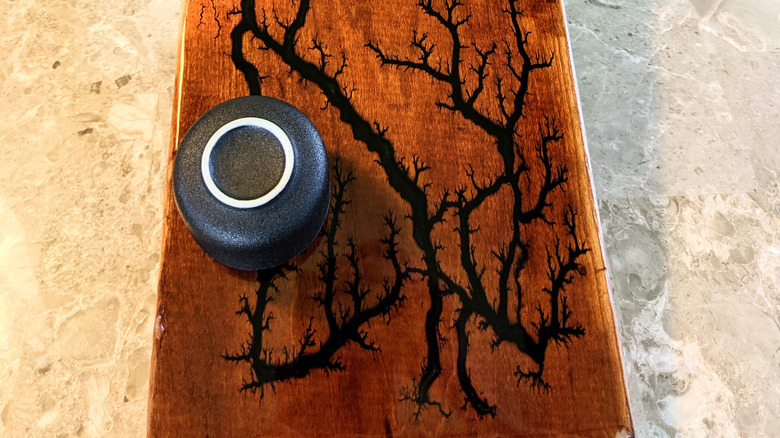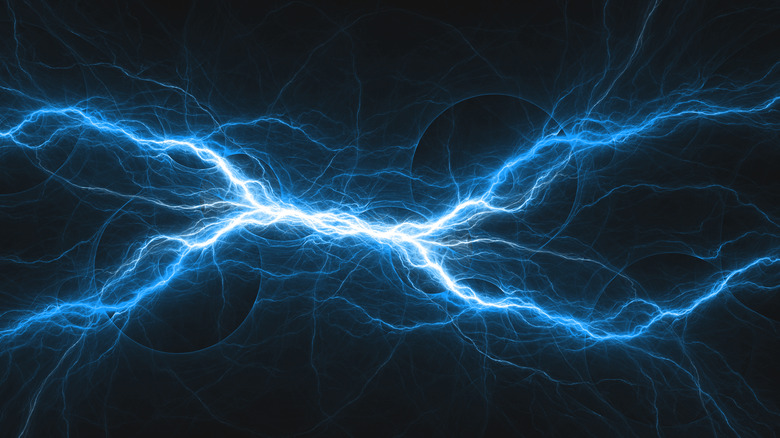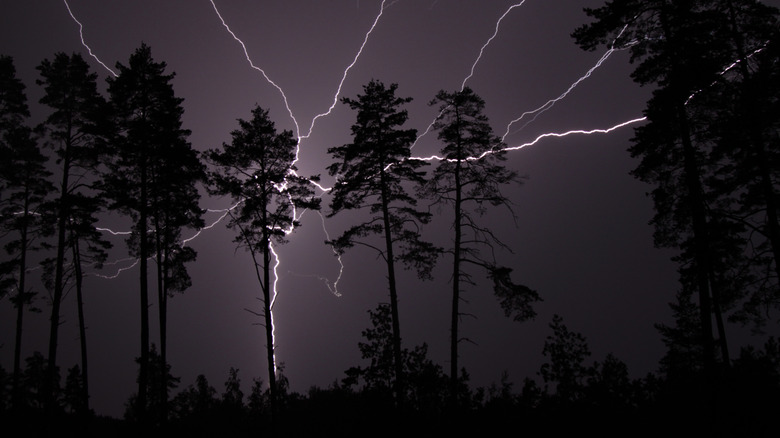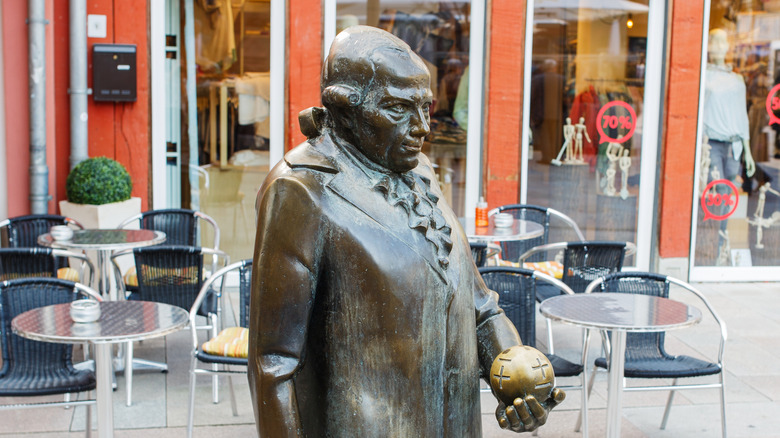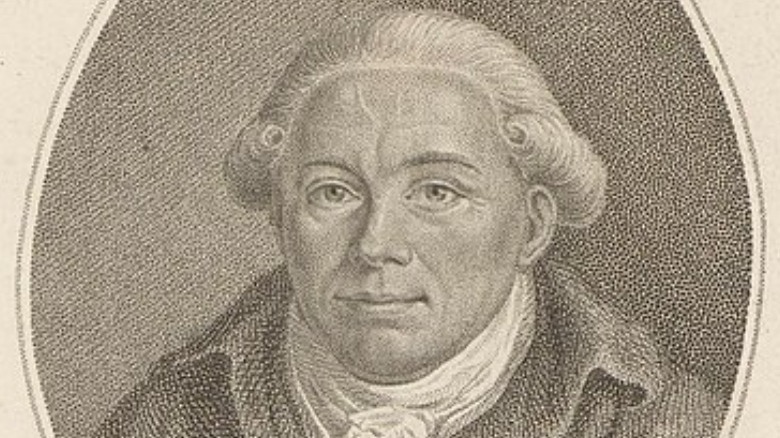What Are Lichtenberg Figures?
Lichtenberg figures are as beautiful as they are deadly. A Lichtenberg figure is a tree-like pattern of branching lines on a surface caused by electricity (per Merriam-Webster). The lightning-like pattern can appear on several natural surfaces, from trees to lightning strike victims.
The science behind Lichtenberg figures led to the modern-day photocopier and laser printer (via Chemistry World). However, many DIY artists are dying from attempting to make ethereal patterns at home using wood or plexiglass (per The American Association of Woodturners).
To make the pattern, dust or fine powder settles on an insulated surface that has just received the flow of an electric current (via Here. There. Everywhere). If a surface is insulated, it can't conduct the electricity, meaning that the current passes over or through the surface (per The Physics Classroom). After the dust makes contact with the surface, it creates a leaf- or vein-like pattern. The Lichtenberg figures resemble ghostly trees or lightning suspended in the air when displayed in resin or plexiglass and backlit. That said, making a Lichtenberg figure at home can be deadly.
DIY artists are dying
Burning wood with electrical currents to create Lichtenberg patterns has become a popular DIY trend. Artists often pour blue resin in the branching lines to mimic an areal view of a river. The art is called fractal burning because Lichtenberg figures are fractals — a recurring pattern found all over the natural world, where any small part of the pattern reflects the whole. If you zoom in or out, the pattern remains the same (via Science World). It is no wonder artists are drawn to the stunning patterns, reflecting the science of the natural world.
However, the attempt has killed amateur artists and expert electricians alike, according to The American Association of Woodturners (AAW). Frequent accidents prompted the organization to ban the process at its events and in all its written materials. In a statement, the chair of the AAW's safety committee urged community members to throw away their equipment. "There are many ways to express your creativity. Do not use fractal burning. ... This could save your life."
Online art tutorials urge deadly hacks
In Oregon, a 26-year-old woman was at home making fractal woodburnings. She had followed an online tutorial instructing her to remove a high-voltage transformer from her microwave. She then used the transformer to create the electrical surge that would burn the wood. After the woman began the burning process, a friend in another room heard the woman groaning (per JECP Open, posted on Wiley Online Library). The friend entered the room to see the woman clutching the electric device as it arced, meaning hot electricity jumped from one source to the other. Arcing electricity can reach temperatures of up to 35,000°F (via Clover Electric). Luckily the friend was able to release the woman from the arc and take her friend to the hospital, but not without the woman receiving severe injuries, including burns and the eventual amputation of a finger (per JECP Open).
A case report from Harney District Hospital that cared for the woman found that "The mortality rate associated with fractal wood burning cases is exceedingly high" (per JECP Open). In response to the death of a southern Australian man from fractal burning, Jim Corbett from Australia's Office of the Technical Regulator said, "I personally can't think of anything more dangerous that you could do." He expressed concern about the numerous online tutorials for the art process. Corbett suggested that people are generally unafraid of electricity, which is misguided (via ABC Southeast SA). People are more afraid of what they can see.
Lichtenberg figures: traces of lightning
Eerily, human bodies also produce Lichtenberg figures after lightning strikes. The fractal patterns resemble red feathers snaking across the skin (per NBC News). Electric discharges contacting insulated surfaces create Lichtenberg figures, and lightning is essentially a large electric discharge (via IFL Science). While lightning strikes are rare, they are deadly. The chance of getting struck by lightning is one in 500,000. Still, lightning strikes are "the leading causes of weather-related fatalities," according to the Centers for Disease Control and Prevention. Those left with only Lichtenberg figures on their skin are the lucky ones. Lightning strikes leave three-quarters of their victims with varying permanent disabilities (per BBC).
The marks are sometimes called "lightning flowers" or "lightning trees" and are caused by capillaries bursting (per BBC). The patterns usually disappear within one to two days. Beyond that, scientists and doctors know little else (via Legal Medicine, posted on Science Direct). In February 2022, a case report from the University of Verona told of a never-before-seen green Lichtenberg figure on a deceased lightning victim, leaving scientists stumped (per Legal Medicine). Lichtenberg figures, while known phenomena, are still a scientific mystery.
Who discovered Lichtenberg figures?
We can thank the 18th-century German physicist and satirist Georg Christian Lichtenberg for discovering Lichtenberg figures. While not as famous as his contemporaries James Watt and Allesandro Volta, he still made significant scientific discoveries. Lichtenberg's somewhat lonely upbringing was in stark contrast to his later life as a humorist, schmoozer, and Cassanova — in addition to being a successful scientist (per Chemistry World).
Born in 1742, he was the youngest of 17 children. He had a spine condition that gave his back a hump and caused him breathing difficulties later in life (via American Physics Society). While he describes his childhood as lonely, perhaps lost in the crowd of his other siblings, he developed a keen wit and sense of humor. His reputation as an excellent conversationalist would later make him an ambassador for Göttingen University, which sent him abroad to do an 18th-century version of networking. Lichtenberg first arrived at Göttingen University at 21 to study physics. Within just six years, the university appointed him as a professor. He stayed with Göttingen for the rest of his career (per Chemistry World).
Beyond his scientific prowess, he is known for his satirical writings that impressed his contemporaries, such as Immanuel Kant and Johann Wolfgang von Goethe (via Chemistry World). Throughout his lifetime, he jotted down terse witticisms and clever observations into notebooks he called Sudelbücher — "Waste Books" — published posthumously in 1801 and in English in 2000 as "The Waste Books" (per Britannica).
How were Lichtenberg figures discvered?
Georg Lichtenberg stumbled upon Lichtenberg figures accidentally. Electricity was his primary scientific interest. Though many other scientists of his day suffered life-threatening injuries or deadly accidents due to studying electricity, Lichtenberg was undeterred (via American Physics Society). One of the instruments he used was an electrophorus — an insulated metal disk (per Chemistry World). Insulated materials cannot carry charges. Instead the electric charge passes over or through the material (via IFL Science). In his experiments, Lichtenberg charged the disk using Allessandro Volta's induction method.
At some point in his studies, Lichtenberg neglected the disk, and a layer of dust grew over the surface. When he returned to resume his experiments, the dust reacted to the electricity by creating the tree-like fractals we know today as Lichtenberg figures. Of the surprising new patterns, he said they looked "like stars at certain points" (per Chemistry World). Lichtenberg soon recreated the anomaly using various insulated materials and powders to mimic the dust. Eventually, he figured out how to reproduce the patterns and press them onto paper. Later, his work would serve as the inspiration for Xerox copying (via American Physics Society). During his life, he developed methods for controlling the patterns, which he placed under glass and framed, creating luminous tree-like designs.
Lichtenberg enjoyed a thriving social, intellectual, and romantic life. His legacy is two-fold: the biting wit of his writing and the exquisite yet potentially lethal Lichtenberg figures.

